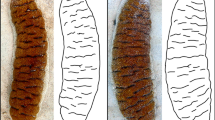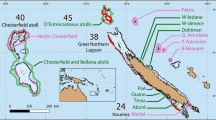Abstract
The shores of coral reef islands are major sites for biodiversity, but unfortunately they are also subject to strong anthropogenic disturbances. Indeed vast arrays of organisms live exclusively in these very narrow and well structured zones, many others depend on the rich and diverse micro-habitats for essential part of their life cycle (to reproduce, forage, etc.). Sea kraits are sea snakes that depend on the shore of coral islets; they forage at sea but digest, reproduce and rest on land. They have been killed in extremely large numbers in many places, causing local extinctions. In the current study we demonstrate through recapture and translocation studies that these snakes exhibit a strong and fine-scale fidelity for particular segments of the shore. Consequently, these specific areas should be under strong protection, as it the case for the breeding beaches used by marine mammals, birds or turtles.


Similar content being viewed by others
References
Alcala AC (2004) Marine reserves as tool for fishery management and biodiversity conservation: natural experiments in the central Philippines, 1974–2000. Silliman University-Angelo King Center for Research and Environmental Management, Dumaguete city
Bacolod PT (1984) Notes on sea snake fishery on Gato islet, Cebu Island, Philippines and a proposal for a conservation and management programme. Philipp Sci 21:155–163
Bacolod PT (1990) The biology of some commercially important species of snakes (Hydrophiidae) in the Visayas Sea. Philipp Sci 27:61–88
Bellwood DR, Hughes TP, Folke C et al (2004) Confronting the coral reef crisis. Nature 429:827–833. doi:10.1038/nature02691
Bonnet X, Brischoux F (2008) Thirsty sea snakes forsake their shelter during rainfall. Aust Ecol 33:911–921. doi:10.1111/j.1442-9993.2008.01917.x
Bonnet X, Ineich I, Shine R (2005) Terrestrial locomotion in sea snakes: the effects of sex and species on cliff-climbing ability in sea kraits (Serpentes, Elapidae, Laticauda). Biol J Linn Soc Lond 85:433–441. doi:10.1111/j.1095-8312.2005.00505.x
Bonnet X, Brischoux F, Pearson D et al (2009) Beach-rock as a keystone habitat for sea kraits. Environ Conserv (in press)
Brischoux F, Bonnet X (2008) Estimating the impact of sea kraits on the anguilliform fish community (Congridae, Muraenidae, Ophichthidae). Aquat Living Resour 21:395–399. doi:10.1051/alr:2008046
Brischoux F, Bonnet X (2009) Life history of sea kraits in New Caledonia. Mem Mus Natl Hist Nat (in press)
Brischoux F, Bonnet X, Shine R (2007) Foraging ecology of sea kraits (Laticauda spp.) in the Neo-Caledonian lagoon. Mar Ecol Prog Ser 350:145–151. doi:10.3354/meps07133
Castilla JC (1989) Human exclusion from rocky intertidal of Las Cruces, central Chile: effects on Durvillaea antarctica (Phaeophyta, Durvilleales). Mar Ecol Prog Ser 50:203–214. doi:10.3354/meps050203
Chapman MG, Bulleri F (2003) Intertidal seawalls—new features of landscape in intertidal environments. Landsc Urban Plan 62:159–172. doi:10.1016/S0169-2046(02)00148-2
Cogger H, Heatwole H (2006) Laticauda frontalis (de Vis, 1905) and Laticauda saintgironsi n. sp. from Vanuatu and New Caledonia (Serpentes: Elapidae: Laticaudinae)—a new lineage of sea kraits? Rec Aust Mus 58:245–256
Guinotte JM, Buddemeier RW, Kleypas JA (2003) Future coral reef habitat marginality: temporal and spatial effects of climate change in the Pacific basin. Coral Reefs 22:551–558. doi:10.1007/s00338-003-0331-4
Hawkins JP, Roberts CM (1994) The growth of coastal tourism in the Red Sea: present and possible future effects on coral reefs. Ambio 23:503–508
Heatwole H (1999) Sea Snakes. Australian Natural History Series. University of New South Wales, Australia
Hughes TP (1994) Catastrophes, phase-shifts, and large-scale degradation of a Caribbean coral-reef. Science 265:1547–1551. doi:10.1126/science.265.5178.1547
Hughes TP, Baird AH, Bellwood DR et al (2003) Climate change, human impacts, and the resilience of coral reefs. Science 301:929–933. doi:10.1126/science.1085046
Ineich I, Laboute P (2002) Sea snakes of New Caledonia. IRD et Muséum national d’Histoire naturelle Editions, Collection Faune et flore tropicales, Paris
Ineich I, Bonnet X, Brischoux F et al (2007) Anguilliform fishes and sea kraits: neglected predators in coral reef ecosystems. Mar Biol (Berl) 151:793–802. doi:10.1007/s00227-006-0527-6
Kathiresan K, Qasim SZ (2005) Biodiversity of mangrove ecosystems. Hindustan Publishing, New Delhi
Linden O (1999) Coral mortality in the tropics: massive causes and effects. Ambio 27:588
Menge BA (1995) Indirect effects in marine rocky intertidal interaction webs: patterns and importance. Ecol Monogr 65:21–74. doi:10.2307/2937158
Orams MB (2001) Feeding wildlife as a tourism attraction: a review of issues and impacts. Tour Manage 23:281–293. doi:10.1016/S0261-5177(01)00080-2
Pandolfi JM, Bradbury RH, Sala E et al (2003) Global trajectories of the long-term decline of coral reef ecosystems. Science 301:955–958. doi:10.1126/science.1085706
Polis GA, Hurd SD (1996) Linking marine and terrestrial food webs: allochthonous input from the ocean supports high secondary productivity on small islands and coastal land communities. Am Nat 147:396–423. doi:10.1086/285858
Prior M, Ormond R, Hitchen R et al (1995) The impact on natural resources of activity tourism: a case study of diving in Egypt. Int J Environ Stud 48:201–209. doi:10.1080/00207239508710990
Reed RN, Shine R, Shetty S et al (2002) Sea kraits (Squamata: Laticauda spp.) as a useful bioassay for assessing local diversity of eels (Muraenidae, Congridae) in the western Pacific Ocean. Copeia 2002:1098–1101. doi:10.1643/0045-8511(2002)002[1098:SKSLSA]2.0.CO;2
Riegl B (2003) Climate change and coral reefs: different effects in two high-latitude areas (Arabian Gulf, South Africa). Coral Reefs 22:433–446. doi:10.1007/s00338-003-0335-0
Roberts CM, McClean CJ, Veron JEN et al (2002) Marine biodiversity hotspots and conservation priorities for tropical reefs. Science 295:1280–1284. doi:10.1126/science.1067728
Rogers CS (1990) Responses to coral reefs and reef organisms to sedimentation. Mar Ecol Prog Ser 62:185–202. doi:10.3354/meps062185
Saint Girons H (1964) Notes sur l’écologie et la structure des populations des Laticaudinae (Serpentes : Hydrophiidae) en Nouvelle-Calédonie. Rev Ecol (Terre Vie) 111:185–214
Seigel RA, Collins JT (2003) Snakes. Ecology and behaviour. Blackburn press, USA
Sheppard CRC (2003) Predicted recurrences of mass coral mortality in the Indian Ocean. Nature 425:294–297. doi:10.1038/nature01987
Shetty S, Shine R (2002) Philopatry and homing behavior of sea snakes (Laticauda colubrina) from two adjacent islands in Fiji. Conserv Biol 16:1422–1426. doi:10.1046/j.1523-1739.2002.00515.x
Walker DI, Ormond RFG (1982) Coral death from sewage and phosphate pollution at Aqaba, Red Sea. Mar Pollut Bull 13:21–25. doi:10.1016/0025-326X(82)90492-1
Acknowledgments
R. Cambag helped to set up the capture areas. S. Lorioux and M. De Crignis helped during fieldwork. We thank F. Devinck, C. Goiran and D. Ponton (DRN Province Sud, Aquarium de Nouméa, IRD). The study was carried out under permits # 6024-179/DRN/ENV and # 6024-3601/DRN/ENV.
Author information
Authors and Affiliations
Corresponding author
Rights and permissions
About this article
Cite this article
Brischoux, F., Bonnet, X. & Pinaud, D. Fine scale site fidelity in sea kraits: implications for conservation. Biodivers Conserv 18, 2473–2481 (2009). https://doi.org/10.1007/s10531-009-9602-x
Received:
Accepted:
Published:
Issue Date:
DOI: https://doi.org/10.1007/s10531-009-9602-x




